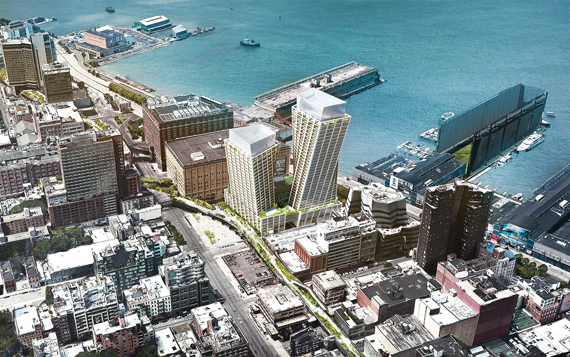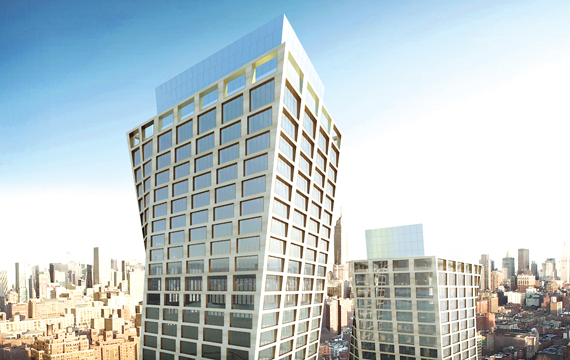Trending
Dressing up the High Line
With his design for HFZ, Bjarke Ingels departs from his radical roots

Bjarke Ingels, the principal architect of BIG (Bjarke Ingels Group), must get tired of people marveling about his relative youth. Even today at 42, an age when most of his peers still labor in total obscurity, the Danish designer shines out as a star, with more commissions in the works than most established architects see in their entire careers. Plans for his first project in New York, VIA 57 West — a daring pyramid-shaped residential tower along the West Side Highway — made him an overnight sensation back in 2012.
Since then, he has gone on to design the now-stalled 1,340-foot-tall 2 World Trade Center; the Spiral, a 65-story office tower in Hudson Yards; and the curving slab of a 233-unit apartment building in East Harlem.
And, just beginning to rise along the High Line at 76 Eleventh Avenue is one of Ingels’ most ambitious projects to date: a pair of buildings for developer HFZ Capital. Officially known as the Eleventh, the $1.9 billion towers will rise from a landscaped base. Standing 300 and 400 feet tall, respectively, they will loom higher than any other structure in West Chelsea. When the buildings open in 2019, they will feature 240 luxury condos, a Six Senses hotel and retail. Vaguely resembling Santiago Calatrava’s Turning Torso, in Malmö, Sweden, they look like two drunken figures on the verge of keeling over.
Despite all the fanfare, in terms of a track record of built projects in NYC, Ingels has up to now seen only one of his designs come to life. That would be VIA 57 West, at 625 West 57th Street, which has 709 rental units developed by the Durst Organization. I wrote about the plan well before ground was broken, but looking at the finished product offers some clues as to the fate of the architect’s other projects.

Bjarke Ingels
As it stands today, VIA 57 West looks something like a torqued pyramid, or perhaps a quarter of a watermelon that’s had a large chunk surgically extracted from its center. On paper, the building seemed so bold — especially in the context of the generally unadorned boxes that largely make up the New York City skyline — that it’s no wonder the concept catapulted Ingels to overnight fame. As a completed work, however, it seems to have failed to live up to its thrilling promise. The greatest paradox of this building is that, despite its great bulk, it fits into the crowded Manhattan grid in such a way that it remains all but invisible until you arrive and are standing right in front of it. Even then, you need to cross the West Side Highway to get a decent view. Worse, the main beneficiaries of this project’s drama end up being the good people of Weehawken, on the Hudson’s far shores. Only from there is a good view of the main axis of the project, which reveals it in all its pyramidal force with the excised center, entirely visible. This is the view that wowed developers and critics alike.
But does it live up to that promise? To me, the building seems more eccentric than bold. And, as so often happens with Manhattan development, the sense of a barely adequate rendering of the architect’s vision doesn’t help. Of course, such matters largely lie beyond the architect’s control, resulting as they do from developers’ desires to cut corners wherever possible to maximize financial returns. Harder to excuse is the lackluster grayish-green hue that dominates this project, as well as details such as a sequence of staggered windows protruding from the inner carved-out wall and elsewhere. It is hard to see what visual or practical advantage this maneuver delivers, other than making the pyramid look indisputably “starchitecty.” Even more disappointing is the base of the building, where Ingels seems to have reverted to the tired Manhattan norm.
Where the boldness of VIA 57 West fares best, oddly enough, is on its relatively unheralded north and east facades. There, its angular masses stack up in odd and unpredictable ways to form some of the most striking sights in all of contemporary New York City architecture.

Rendering of 76 Eleventh Avenue
Conceived more than five years ago, VIA 57 West represents an earlier stage of Ingels’ design sensibility and his whole Deconstructivist idiom. He rejects that label, but it seems to define much of his work to date. A lot has changed, however, since the pyramid. Nowhere is that shift clearer than in his latest renderings for 76 Eleventh Avenue. Here we see a maturation, even a taming of BIG’s rebelliousness and perhaps even of Ingels himself.
In this project, he reintegrates Deconstructivism with the forces of order. The two towers behave like many others in Manhattan, notwithstanding the glaring fact that they appear to rear back at odd angles. According to a press release, Ingels said his design drew “inspiration from New York City’s classic Modernist structures and cultural institutions, while skewing traditional skyscraper geometry with rotating forms that maximize views from both towers.” The first part of that equation sounds fair enough: The two towers rising in all their pristine whiteness echo the modularity long associated with mainstream modernism. But a more recent source of inspiration may be Rafael Viñoly’s 432 Park Avenue, now the tallest residential building in the Western Hemisphere. Ingels has spoken well of that development, even though few buildings in Manhattan — or anywhere else in recent years — show a more austere geometrical rectitude than Viñoly’s stripped-down spire.
Of course, the two projects have striking differences, among them the swerves and torqued masses of 76 Eleventh Avenue. But it also looks as though Ingels took 432 Park, chopped it in two, twisted each half and then pushed them away from each other. It’s also worth noting that Ingels’ initial plans called for more aggressive contortions. He now seems to have found a way to tame his style (a move also evident at his East Harlem development) without entirely surrendering it. The result, at least on paper, is a mature and promising design, but it’s one that looks to have been reined in by the blandness that defines so much of the city’s architectural culture. In the process, this raises the once unimagined question: Is Bjarke Ingels changing Manhattan, or is it vice versa?




